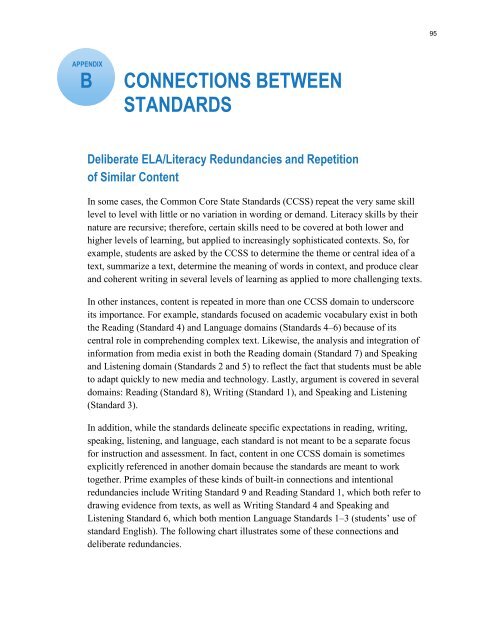CCRStandardsAdultEd
Create successful ePaper yourself
Turn your PDF publications into a flip-book with our unique Google optimized e-Paper software.
95<br />
APPENDIX<br />
B<br />
CONNECTIONS BETWEEN<br />
STANDARDS<br />
Deliberate ELA/Literacy Redundancies and Repetition<br />
of Similar Content<br />
In some cases, the Common Core State Standards (CCSS) repeat the very same skill<br />
level to level with little or no variation in wording or demand. Literacy skills by their<br />
nature are recursive; therefore, certain skills need to be covered at both lower and<br />
higher levels of learning, but applied to increasingly sophisticated contexts. So, for<br />
example, students are asked by the CCSS to determine the theme or central idea of a<br />
text, summarize a text, determine the meaning of words in context, and produce clear<br />
and coherent writing in several levels of learning as applied to more challenging texts.<br />
In other instances, content is repeated in more than one CCSS domain to underscore<br />
its importance. For example, standards focused on academic vocabulary exist in both<br />
the Reading (Standard 4) and Language domains (Standards 4–6) because of its<br />
central role in comprehending complex text. Likewise, the analysis and integration of<br />
information from media exist in both the Reading domain (Standard 7) and Speaking<br />
and Listening domain (Standards 2 and 5) to reflect the fact that students must be able<br />
to adapt quickly to new media and technology. Lastly, argument is covered in several<br />
domains: Reading (Standard 8), Writing (Standard 1), and Speaking and Listening<br />
(Standard 3).<br />
In addition, while the standards delineate specific expectations in reading, writing,<br />
speaking, listening, and language, each standard is not meant to be a separate focus<br />
for instruction and assessment. In fact, content in one CCSS domain is sometimes<br />
explicitly referenced in another domain because the standards are meant to work<br />
together. Prime examples of these kinds of built-in connections and intentional<br />
redundancies include Writing Standard 9 and Reading Standard 1, which both refer to<br />
drawing evidence from texts, as well as Writing Standard 4 and Speaking and<br />
Listening Standard 6, which both mention Language Standards 1–3 (students’ use of<br />
standard English). The following chart illustrates some of these connections and<br />
deliberate redundancies.


